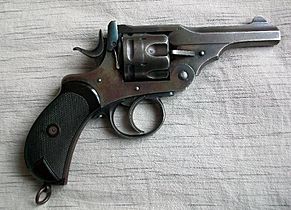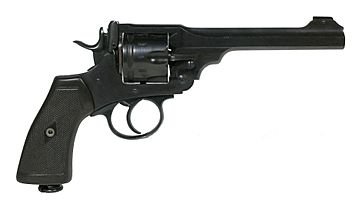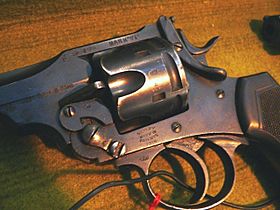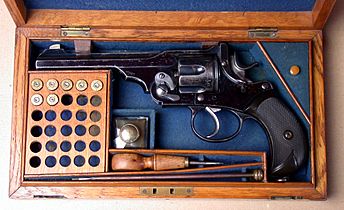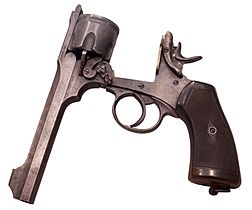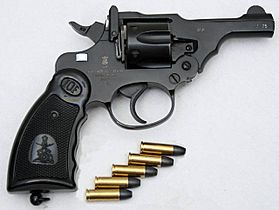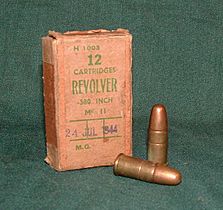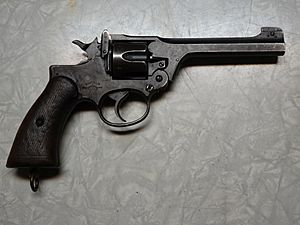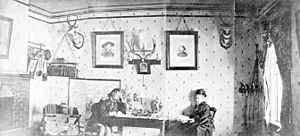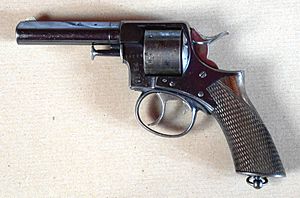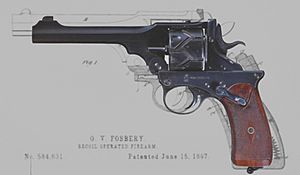Webley Revolver facts for kids
Quick facts for kids Webley Revolver |
|
|---|---|
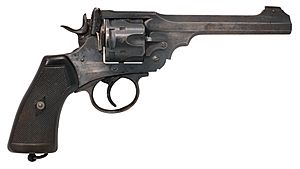
A Webley Mk. VI top-break revolver.
|
|
| Type | Service revolver |
| Place of origin | United Kingdom |
| Service history | |
| In service | 1887–1970 |
| Used by | See Users |
| Wars | Second Boer War Boxer Rebellion World War I Easter Rising Irish War of Independence Irish Civil War World War II Northern Campaign Indonesian National Revolution Malayan Emergency First Indochina War Korean War Vietnam War British colonial conflicts Border Campaign The Troubles |
| Production history | |
| Designer | Webley & Scott |
| Designed | 1887 |
| Manufacturer | Webley & Scott, RSAF Enfield |
| Produced | 1887–1924 |
| No. built | approx. 125,000 |
| Specifications (Revolver Mk VI) | |
| Mass | 2.4 lb (1.1 kg), unloaded |
| Length | 11.25 in (286 mm) |
| Barrel length | 6 in (150 mm) |
|
|
|
| Cartridge |
|
| Calibre | .455 (11.6 mm) |
| Action | Single or double action |
| Rate of fire | 20–30 rounds/minute |
| Muzzle velocity | 620 ft/s (190 m/s) |
| Effective firing range | 50 yd (46 m) |
| Feed system | 6-round cylinder |
| Sights | Fixed front blade and rear notch |
The Webley Revolver was a very important handgun. It was used by the armed forces of the United Kingdom and many countries of the British Empire. This happened from 1887 all the way to 1970.
The Webley is a special type of revolver called a top-break. This means it opens up at the top to load and unload. When you break it open, it automatically pushes out the used cartridges from its cylinder.
The first military version, the Webley Mk I, came out in 1887. A later model, the Mk IV, became famous during the Second Boer War (1899–1902). The Mk VI was made in 1915 during World War I and is the most well-known model.
Webley revolvers used large .455 Webley cartridges. This made them some of the most powerful top-break revolvers ever made. The .455 Webley is no longer used by the military. However, a smaller version, the .38/200 Webley Mk IV, was still used by police in some countries as of 1999.
Contents
History of the Webley Revolver
Webley & Scott is the company that made these revolvers. They started making guns in the mid-1800s. In 1887, the British Army needed a new revolver. Their old ones were not very good.
Webley & Scott offered their .455 calibre Webley Self-Extracting Revolver. The army was very impressed! They thought it was much better than their old guns. So, on November 8, 1887, they officially chose it. They called it the "Pistol, Webley, Mk I".
The Webley revolver changed over time. The last main version was the Mk VI. This model was made from 1915 to 1923. The large .455 Webley revolvers were stopped from military use in 1947. But the smaller Webley Mk IV .38/200 stayed in service until 1970. It was used alongside the Enfield No. 2 Mk I revolver.
You could also buy Webley revolvers if you were a civilian. Many military officers bought them too. The very last Mk VI was sold from the factory in 1957. It went to Nigeria.
Webley Revolvers in Military Use
The Boer War and the Webley Mk IV
The Webley Mk IV was made in 1899. It became known as the "Boer War Model". Many officers bought it before going to fight in the Second Boer War. The Mk IV was used with other handguns during this war.
Webley Revolvers in World War I
When World War I started, the main Webley revolver was the Mk V. But there were many more Mk IV revolvers being used. The Mk V was adopted in 1913.
These revolvers were given to officers, airmen, and naval crews. They were also given to soldiers in trench raids, machine-gun teams, and tank crews. Many Allied soldiers used them as a sidearm.
The Mk VI was very strong and dependable. It worked well in the muddy conditions of trench warfare. People even made special things for it. These included a bayonet and devices to load it faster. You could even add a stock to turn it into a small carbine.
There was such a high demand for these revolvers that Britain had to buy guns from other countries. America provided some revolvers. Spanish gun makers also made copies of popular guns to help.
Webley Revolvers in World War II
During World War II, the main British military pistol was the Enfield No. 2 Mk I. But there weren't enough handguns. So, the Webley Mk IV (.38/200) and Webley Mk VI (.455) were also given to soldiers.
Webley Revolvers After the Wars
Webley revolvers were still used by British and Commonwealth forces after World War II. There were many of them in military storage. However, there wasn't much ammunition for them. This lack of ammunition meant they didn't get used much. This is partly why they lasted so long! One soldier joked that by 1963, they only got "two cartridges per man, per year."
The Webley Mk IV .38 revolver was finally replaced in 1963. But it was used in the Korean War, the Suez Crisis, and other conflicts. Some Enfield No. 2 Mk I revolvers were still in use as late as 1970.
Webley Revolvers in Police Use
Police forces in places like Hong Kong and Singapore used Webley revolvers from the 1930s. Some police Webleys even had safety catches, which is unusual for a revolver. These were slowly replaced in the 1970s. The London Metropolitan Police also used Webley revolvers. Many police units in British colonies used them too.
Even today, a factory in India makes .38 calibre revolvers. They are clearly based on the Webley Mk IV .38 service pistol.
Different Webley .455 Revolver Models
There were six main types of .455 calibre Webley revolvers used by the British military:
- Mk I: The first one, adopted in 1887. It had a 4-inch (100 mm) barrel. The Mk I* was an upgraded version of the Mk I.
- Mk II: Similar to the Mk I, but with changes to the hammer and grip. Adopted in 1895.
- Mk III: Like the Mk II, but with changes to the cylinder. Adopted in 1897. Most were not used by the military, except for some that went to the Royal Navy.
- Mk IV: Known as the "Boer War" Model. Made with stronger steel. Adopted in 1899.
- Mk V: Similar to the Mk IV, but with a wider cylinder. This allowed it to use newer types of cartridges. Adopted in 1913.
- Mk VI: Like the Mk V, but with a different grip shape and a 6-inch (150 mm) barrel. Adopted in 1915. It was also made by another factory called RSAF Enfield.
The Webley Mk IV .38/200 Service Revolver
| Webley Mk IV .38/200 Service Revolver | |
|---|---|
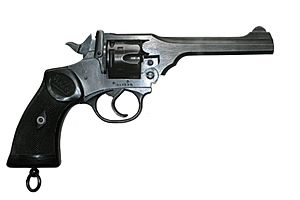 |
|
| Type | Service revolver |
| Place of origin | British Empire |
| Service history | |
| In service | 1932–1963 |
| Used by | United Kingdom & Colonies, British Commonwealth |
| Wars | Second World War, Korean War, British colonial conflicts |
| Production history | |
| Designer | Webley & Scott |
| Designed | 1932 |
| Manufacturer | Webley & Scott |
| Produced | 1932–1978 |
| No. built | approx. 500,000 |
| Specifications | |
| Mass | 2.3 lb (995 g), unloaded |
| Length | 10.25 in (260 mm) |
| Barrel length | 5 in. (125 mm) |
|
|
|
| Cartridge | .380" Revolver Mk IIz |
| Calibre | .38 (9 mm) |
| Action | Double action |
| Rate of fire | 20–30 rounds/minute |
| Muzzle velocity | 620 ft/s (190 m/s) |
| Effective firing range | 50 yd (46 m) |
| Maximum firing range | 300 yd (270 m) |
| Feed system | 6-round cylinder |
| Sights | fixed front post and rear notch |
After World War I, the British military decided that the .455 calibre gun was too big. They thought a smaller .38 calibre pistol would work just as well.
Webley & Scott quickly offered their .38/200 calibre Webley Mk IV revolver. It looked almost the same as the larger .455 Mk VI revolver, just smaller.
But then, the British Government took Webley's design to their own factory, RSAF Enfield. Enfield made a revolver that looked very similar to Webley's .38/200 Mk IV. However, the inside parts were different. You couldn't swap parts between the Webley and the Enfield guns.
The Enfield-designed pistol was chosen in 1932. It was called the Pistol, Revolver, No. 2 Mk I.
Webley & Scott were not happy. They sued the British Government. They wanted money for their research and design work.
RSAF Enfield said that their gun was designed by their own Captain Boys. They said Webley & Scott only helped a little. So, Webley's claim for money was denied.
However, a special group later gave Webley & Scott some money for their work. They received £1250.
During World War II, RSAF Enfield couldn't make enough No. 2 revolvers. Because of this, Webley's Mk IV was also widely used by the British Army.
Other Webley Revolvers
Webley made many other popular revolvers. These were mostly for police and people to buy.
Webley RIC
The Webley RIC model was Webley's first double-action revolver. It was chosen by the Royal Irish Constabulary (RIC) in 1868. That's where it got its name. General George Armstrong Custer owned two of these. He might have used them in the Battle of the Little Bighorn in 1876.
British Bull Dog
The British Bull Dog was a very popular design from Webley. It came out in 1872. It had a 2.5-inch (64 mm) barrel. It could hold five cartridges.
This gun was made to be carried in a coat pocket. Many copies of this design were made in other countries. A Belgian-made British Bulldog revolver was used to assassinate US President James Garfield in 1881.
These revolvers were popular until World War II. Now, they are mostly collector's items. It's hard to find ammunition for them today.
Webley-Fosbery Automatic Revolver
The Webley-Fosbery Automatic Revolver was a very unusual gun. It was made between 1900 and 1915. It could hold six .455 Webley cartridges or eight .38 ACP cartridges.
This revolver had a safety catch, which was rare for revolvers. It was known for being very accurate. This made it popular with target shooters.
Users
 Australia
Australia British Empire
British Empire Canada: Used by the Royal Canadian Mounted Police.
Canada: Used by the Royal Canadian Mounted Police. British Hong Kong
British Hong Kong British Raj
British Raj Imperial State of Iran
Imperial State of Iran Ireland
Ireland Israel
Israel Luxembourg
Luxembourg Malaysia
Malaysia Myanmar: No longer used.
Myanmar: No longer used. Dominion of Newfoundland
Dominion of Newfoundland Philippines
Philippines Pakistan
Pakistan Rhodesia
Rhodesia Siam
Siam Sierra Leone
Sierra Leone Singapore: No longer used.
Singapore: No longer used. Switzerland
Switzerland Tunisia: No longer used.
Tunisia: No longer used. Tanzania
Tanzania Union of South Africa
Union of South Africa New Zealand
New Zealand


